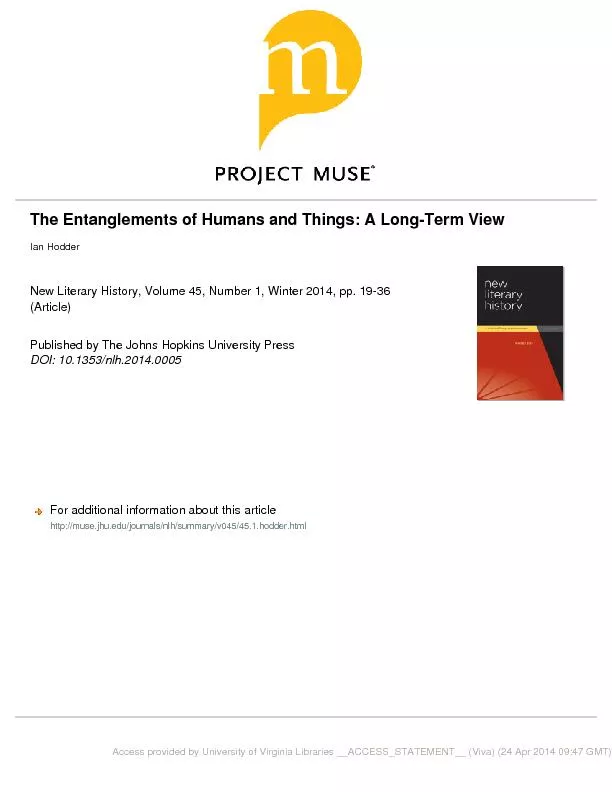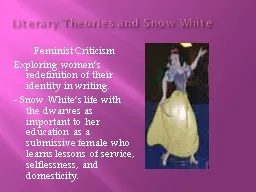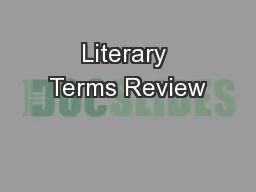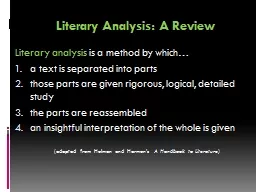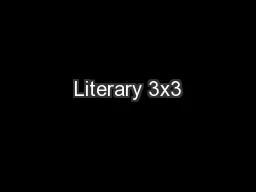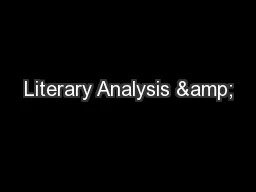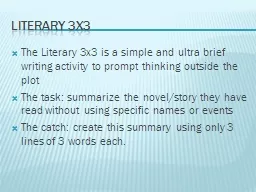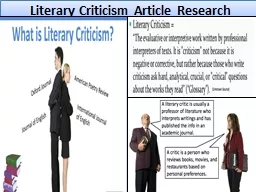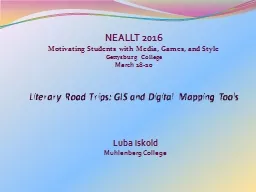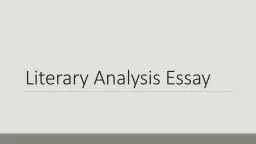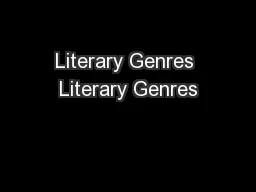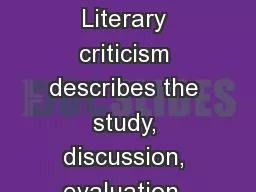PDF-new literary history
Author : giovanna-bartolotta | Published Date : 2016-06-01
the entanglements of humans and things
Presentation Embed Code
Download Presentation
Download Presentation The PPT/PDF document "new literary history" is the property of its rightful owner. Permission is granted to download and print the materials on this website for personal, non-commercial use only, and to display it on your personal computer provided you do not modify the materials and that you retain all copyright notices contained in the materials. By downloading content from our website, you accept the terms of this agreement.
new literary history: Transcript
the entanglements of humans and things. brPage 1br New Literary History 2010 41 695715 AvantGarde and NeoAvantGarde An Attempt to Answer Certain Critics of Theory of the AvantGarde eter 57596rger De64257nitions hat is an Feminist Criticism. Exploring women’s redefinition of their identity in writing.. - Snow White’s life with the dwarves as important to her education as a submissive female who learns lessons of service, selflessness, and domesticity.. 2014-2015. Alliteration. stylistic device in which a number of words, having the same first consonant sound, occur close together in a . series. “From forth the fatal loins of these two foes. ; A . Literary analysis . is a . method by which…. a text is separated into parts. those parts are given rigorous, logical, detailed study. the parts are reassembled . an insightful interpretation of the whole is given . The Literary 3x3 is a simple and ultra brief writing activity to prompt students to think outside the plot. The task: students summarize the novel/story they have read without using specific names or events. Close Reading Assignment. Climax. most exciting/suspenseful moment. Resolution. problems are . resolved. Complications/Rising Actions. new problems arise. Basic Situation/Exposition. conflict. . is introduced. The Literary 3x3 is a simple and ultra brief writing activity to prompt . t. hinking outside . the plot. The task: . summarize . the novel/story they have read without using specific names or events. Jocelyn Wiley (American Community School of Abu Dhabi). Title Goes Here. This is the standard page design. . This content area is to be used for bullet points.. This is the standard page design. . This content area is to be used for bullet points, images, and general content.. “Money . in Jane . Austen”. Robert D. . Hume. The Pennsylvania State University. Abstract. Recent scholars have demonstrated that Jane Austen does not depict a ‘bourgeois’ world. But the attention paid to socio-economic issues of rank or class in the novels has been accompanied by relatively little specificity about the magnitude and buying power of particular sums, especially incomes. Austen lived a very straitened life in economic terms, and she was, unsurprisingly, hyperconscious of money. Each novel poses economic questions, but the difficulty of determining present-day-equivalent buying power makes it hard to judge the magnitude of the sums involved. While recognizing that ‘retail price’ and ‘average earnings’ may diverge as measures of inflation by a factor of more than thirteen, this essay argues that a multiplier somewhere between 100 and 150 produces a generally plausible equivalent today. It also argues that attention to the size and buying power of the specified incomes of Austen’s principals underlines their elite status. Bingley’s £4000–5000 per annum puts him in the top one-tenth of 1% of the population, and . NEALLT 2016. Motivating . Students with Media, Games, and Style. Gettysburg College . March 18-20 . Luba Iskold . Muhlenberg College. Presentation Outline. Background. Why use Literary Road Trips?. Software Options. Norton Field Guide . . “Literary analyses are essays in which we examine literary texts closely to understand their messages, interpret their meanings, and appreciate their writers’ techniques” (81).. You need to keep up with your . Vocabulary Notebook. . Don’t lose your terms! You might be able to use them – . be RESPONSIBLE!!. We will use the following terms:. Character Antagonist Protagonist. Literary: anything having to do with written works (books, poems, stories…). Literary Genres. Literary: anything having to do with written works (books, poems, stories…). Genres: this is where books are sorted and divided by different topics, areas, departments, subjects or . lenses. . applied to an object under consideration; they bring certain qualities into focus or call our attention to particular issues.. . Why do we use different forms of criticism?. Literary criticism is an extension of the social activity of interpreting. One reader writes down his or her views on what a particular work of literature means so that others can respond to that interpretation. The critic's specific purpose may be to .
Download Document
Here is the link to download the presentation.
"new literary history"The content belongs to its owner. You may download and print it for personal use, without modification, and keep all copyright notices. By downloading, you agree to these terms.
Related Documents

